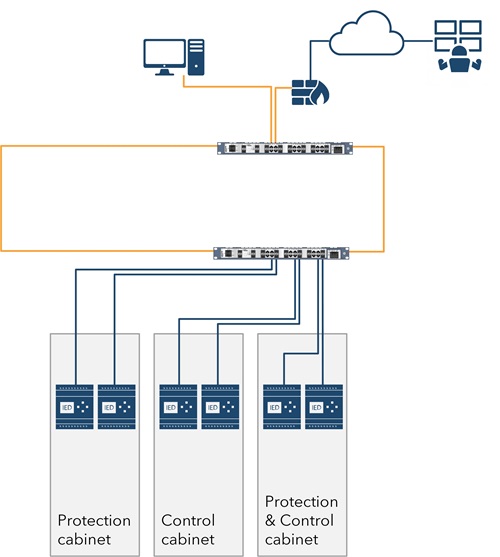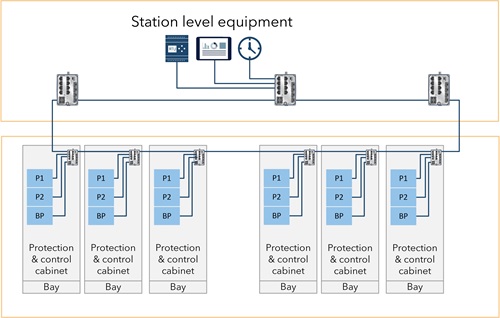Substation examples with RSTP
RSTP (Rapid Spanning Tree Protocol) is chosen as a redundancy protocol in IEC 61850-8-1. RSTP is non-proprietary, allowing easy integration between vendors.
RSTP provides redundancy against link and bridge failures, though a drawback is that it is not zero loss. In a worst-case scenario, the recovery time could be up to 20 seconds. This may be acceptable in certain places of a substation network, but not the process bus.
There are also other protocols, like the Westermo FRNT, that are not chosen by the standard but do however provide much faster reconfiguration time compared to RSTP.
Station bus with RSTP

Click for high resolution image
This example represents a common way of creating a redundant station bus. The station bus with RSTP is a simple and very common solution, involving using a high-port-density switch centrally and connecting all devices to this switch.
Substation automation rack switches are placed at station level with station level equipment, and fiber connections are used from station level to bay level equipment.
While this topology provides some level of redundancy, it is limited. The redundancy is mainly on the station bus (trunk) between the switches, but not on the connections to individual devices .
Station bus as ring

Click for high resolution image
The station bus ring topology involves connecting multiple switches in a ring configuration. This setup enables additional redundancy and ensures that communication can continue even if one switch unexpectedly fails.
In this example, each switch is placed in different cabinets or locations within the station, and they are interconnected to form a ring topology. This design can use either copper cables or fiber optics, depending on the specific or environmental requirements and distances involved. Typically, fibre would be used outside shielded cabinets and for longer distances.
The ring topology provides redundancy at the network level, ensuring that communication remains uninterrupted even if a single switch may fail. It is also easy to maintain and can be scaled up by adding more switches to the ring. One of the challenges with this topology is the limitation on the number of switches that can be included in the ring due to the handling of hops by RSTP.
See also

Redundancy Solutions with PRP and HSR
To achieve redundancy in substation automation systems, Parallel Redundancy Protocol (PRP) and High-availability Seamless Redundancy (HSR) are very important. Learn about our topology examples that uses either PRP, HSR or a combination of them to create redundant and effective data networks.
See moreMikael Lindahl
Network application specialist

Bitte nutzen Sie für Supportanfragen unser Support Formular
